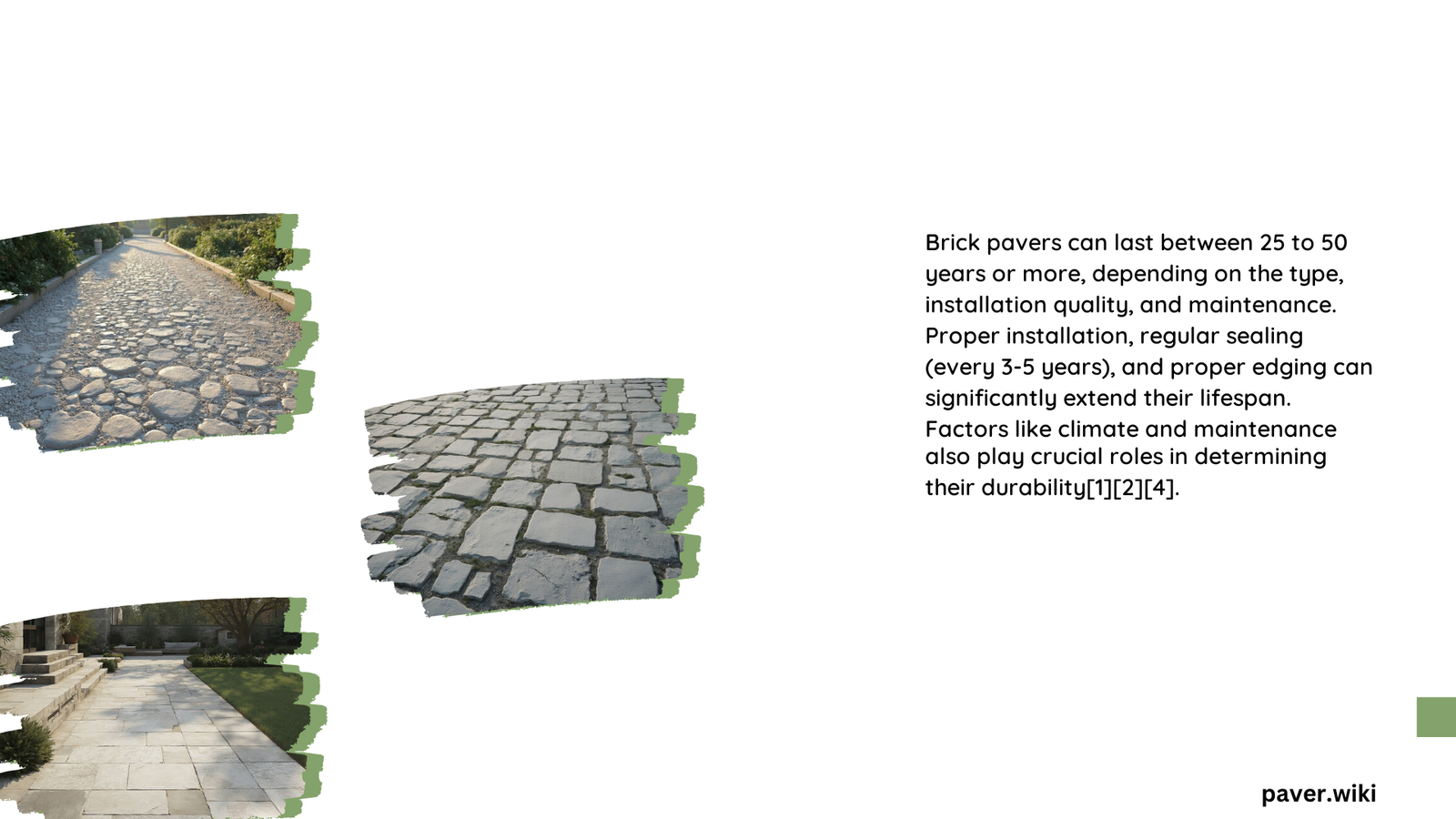Paver bricks are renowned for their exceptional longevity, often outlasting alternative paving materials by decades. With proper installation and maintenance, these versatile outdoor surface solutions can endure for 50 to 100 years, making them a cost-effective and durable choice for driveways, patios, and walkways. Their resilience against various weather conditions, coupled with their aesthetic appeal, positions paver bricks as a superior option for long-lasting outdoor surfaces.
What Factors Influence the Lifespan of Paver Bricks?
The durability of paver bricks is influenced by several key factors:
- Climate and Weather Conditions: Paver bricks exhibit remarkable resistance to diverse weather patterns, including:
- Extreme heat
- Freezing temperatures
- Heavy rainfall
-
UV radiation
-
Quality of Materials: High-quality paver bricks, particularly those made from natural materials, tend to have:
- Lower porosity
- Better structural integrity
-
Enhanced resistance to wear and tear
-
Installation Techniques: Proper installation is crucial for longevity, involving:
- A stable and well-prepared base
- Efficient drainage systems
-
Secure edging to prevent shifting
-
Maintenance Practices: Regular upkeep significantly extends the lifespan of paver bricks, including:
- Routine cleaning
- Periodic sealing
- Prompt repairs when needed
How Do Different Types of Paver Bricks Compare in Longevity?

Various types of paver bricks offer different levels of durability:
| Type of Paver | Average Lifespan | Key Characteristics |
|---|---|---|
| Brick Pavers | 50-100 years | Low porosity, excellent freeze-thaw resistance, high UV resistance |
| Concrete Pavers | 25-50 years | Versatile, cost-effective, prone to color fading |
| Natural Stone Pavers | 100+ years | Extremely durable, unique aesthetics, higher cost |
What Maintenance Practices Extend the Life of Paver Bricks?
To maximize the lifespan of paver bricks, consider the following maintenance practices:
- Regular Cleaning:
- Sweep away debris weekly
-
Pressure wash annually to remove stubborn dirt
-
Sealing:
- Apply a high-quality sealer every 2-3 years
-
Protects against stains, fading, and moisture penetration
-
Weed Control:
- Remove weeds promptly to prevent root damage
-
Use polymeric sand in joints to inhibit weed growth
-
Repair and Replace:
- Address damaged pavers immediately
-
Replace individual bricks as needed to maintain surface integrity
-
Winter Care:
- Use plastic shovels to avoid scratching
- Apply sand instead of salt for ice management
How Does Climate Impact the Longevity of Paver Bricks?
Climate plays a significant role in the durability of paver bricks:
-
Freeze-Thaw Cycles: In colder regions, paver bricks must withstand repeated freezing and thawing. High-quality pavers are engineered to resist cracking and spalling during these cycles.
-
UV Exposure: Areas with intense sunlight require pavers with excellent UV resistance to prevent color fading and material degradation.
-
Moisture Levels: In humid or rainy climates, proper drainage is essential to prevent water accumulation, which can lead to erosion of the base material or frost heave in colder regions.
-
Temperature Extremes: Paver bricks must be able to expand and contract with temperature fluctuations without cracking or becoming brittle.
What Are the Cost Implications of Choosing Paver Bricks for Longevity?
When considering the long-term investment in paver bricks, several cost factors come into play:
- Initial Installation Costs:
- Higher upfront cost compared to poured concrete
-
Professional installation recommended for optimal longevity
-
Maintenance Expenses:
- Regular cleaning: Minimal cost (DIY possible)
- Sealing: Moderate cost every 2-3 years
-
Repairs: Generally low, as individual pavers can be replaced
-
Long-Term Savings:
- Reduced need for full surface replacement
- Lower likelihood of major repairs
-
Potential increase in property value
-
Energy Efficiency:
- Light-colored pavers can reflect heat, potentially reducing cooling costs in warm climates
How Do Paver Bricks Compare to Other Paving Materials in Longevity?
Paver bricks often outperform other paving materials in terms of longevity:
- Asphalt: Typically lasts 15-20 years, requiring more frequent replacement than paver bricks.
- Poured Concrete: Can last 20-30 years but is prone to cracking and difficult to repair without visible patches.
- Gravel: Requires frequent replenishment and doesn’t provide a stable surface like paver bricks.
- Stamped Concrete: While decorative, it doesn’t offer the same flexibility for repairs as individual paver bricks.
What Environmental Factors Can Shorten the Lifespan of Paver Bricks?
Despite their durability, certain environmental factors can impact the longevity of paver bricks:
- Tree Roots: Aggressive root systems can cause pavers to lift and shift.
- Soil Erosion: Inadequate drainage can lead to base material washout.
- Chemical Exposure: Harsh cleaning agents or excessive use of de-icing salts can degrade paver surfaces.
- Heavy Traffic: While durable, extremely heavy or constant vehicle traffic can cause wear over time.
- Seismic Activity: In earthquake-prone areas, ground movement can disrupt paver installations.
How Can Proper Installation Techniques Enhance Paver Brick Longevity?
The installation process is crucial for maximizing the lifespan of paver bricks:
- Proper Base Preparation:
- Excavate to the appropriate depth
- Install a geotextile fabric to prevent soil migration
-
Compact layers of gravel and sand for a stable foundation
-
Precise Leveling:
- Use screeding techniques to ensure a perfectly level sand bed
-
Employ laser levels for large areas to maintain consistent grading
-
Tight Joints:
- Install pavers with minimal gaps
-
Use polymeric sand to lock pavers in place and prevent weed growth
-
Edge Restraints:
- Install robust edging to contain the paver system
-
Choose materials compatible with the local climate
-
Proper Drainage:
- Ensure a slight slope away from structures (typically 1/4 inch per foot)
- Install drainage systems in areas prone to water accumulation
By adhering to these installation best practices, the longevity of paver bricks can be significantly enhanced, often extending their useful life well beyond the average expectations.
In conclusion, paver bricks do indeed last longer than many alternative paving materials when properly installed and maintained. Their durability, coupled with the ability to replace individual units, makes them an excellent choice for those seeking a long-lasting outdoor surface solution.
